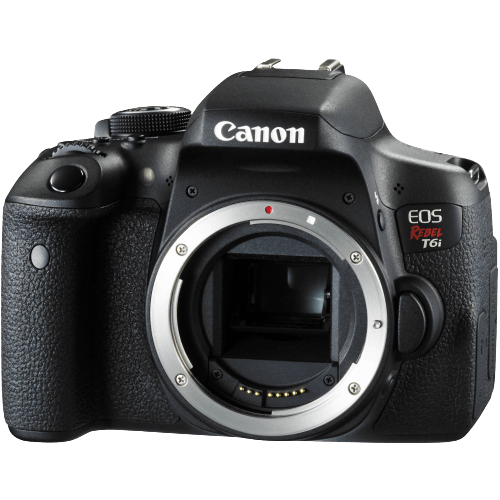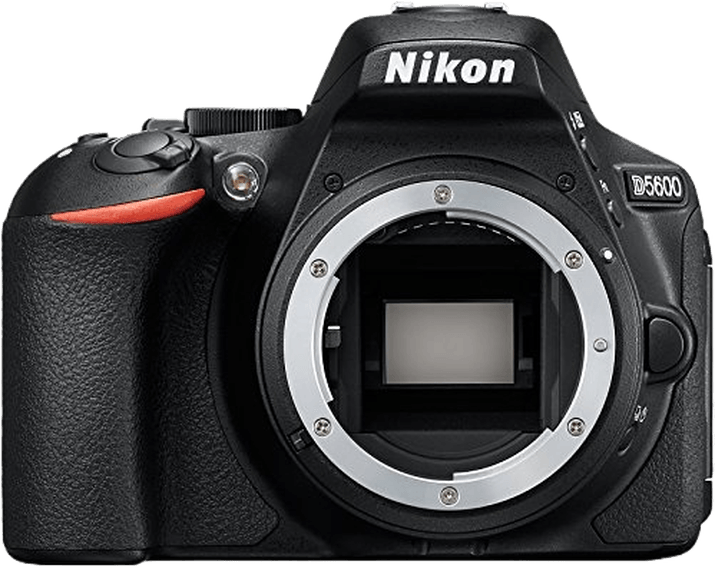Canon EOS Rebel T6i / 750D vs Nikon D5600 Comparison
Canon EOS Rebel T6i / 750D

Nikon D5600

The Nikon D5600 emerges as the winner with a score of 66/100, while the Canon EOS Rebel T6i / 750D trails behind at 56/100. Both cameras are DSLR models, announced in 2015 and 2016, respectively. They share similarities in their launch prices, with the Nikon D5600 priced at $700 and the Canon T6i at $750.
The Nikon D5600 outperforms the Canon T6i with its lighter weight of 465g compared to the T6i’s 555g, and a smaller size of 124 x 97 x 70mm compared to 132 x 101 x 78mm. This makes the Nikon D5600 more portable and convenient for photographers.
On the other hand, the Canon T6i’s higher launch price doesn’t necessarily translate to better performance, as evidenced by its lower score. However, some users may prefer the slightly larger size for a better grip and handling experience.
Taking these specifications into account, the Nikon D5600 is the superior camera in terms of portability and convenience, while the Canon T6i might suit those who prioritize a larger form factor for better handling.
Canon EOS Rebel T6i / 750D vs Nikon D5600 Overview and Optics
The Nikon D5600 wins the optics comparison with a score of 65/100, while the Canon EOS Rebel T6i / 750D receives a score of 59/100. This 6-point difference highlights the superior optical performance of the Nikon D5600.
Both cameras share common specifications, including 24.2 megapixels, a shooting speed of 5, CMOS sensor type, APS-C sensor size, and no image stabilization. However, the Nikon D5600 surpasses the Canon T6i with its higher DXOMARK score for the sensor, scoring 84 compared to Canon’s 71. This means that the Nikon D5600’s sensor performs better in terms of color depth, dynamic range, and low light performance. Additionally, the Nikon D5600 uses the Expeed 4 processor, which contributes to better image quality and faster performance.
On the other hand, the Canon T6i has the advantage of the Digic 6 processor, which is known for providing better noise reduction and improved video quality. However, this advantage is not enough to compensate for the lower DXOMARK score for the sensor.
The Nikon D5600 also benefits from the Nikon F DX lens mount, which offers a wider range of compatible lenses than the Canon EF-S lens mount. This provides greater flexibility and options for photographers using the Nikon D5600.
In the end, the Nikon D5600 outperforms the Canon EOS Rebel T6i / 750D in terms of optics due to its higher DXOMARK score for the sensor and wider range of compatible lenses. While the Canon T6i has some advantages, such as the Digic 6 processor, these are not enough to overcome the Nikon D5600’s superior optical performance.
Canon EOS Rebel T6i / 750D vs Nikon D5600 Video Performance
The Nikon D5600 proves to be the superior camera in terms of video capabilities, scoring 70 out of 100, compared to the Canon EOS Rebel T6i / 750D’s score of 43. Both cameras share some common specifications, such as Full HD video resolution and maximum video dimensions of 1920 x 1080. However, there are key differences that set them apart.
The Nikon D5600 outperforms the Canon T6i in two main areas. Firstly, it has a higher maximum video frame rate of 60fps, compared to the Canon’s 30fps. This allows for smoother and more detailed footage, especially when capturing fast-moving subjects or scenes. Secondly, the Nikon D5600 has a built-in time-lapse functionality, which enables users to create stunning time-lapse videos without the need for additional software or equipment.
On the other hand, the Canon EOS Rebel T6i / 750D does not offer any significant advantages over the Nikon D5600 in terms of video capabilities. Its lower video frame rate and lack of time-lapse functionality make it less versatile and less capable of producing high-quality video content.
Taking these factors into consideration, it is clear that the Nikon D5600 is the better choice for those who prioritize video capabilities in their camera selection. Its higher frame rate and built-in time-lapse functionality provide users with more creative options and better overall video performance. In contrast, the Canon EOS Rebel T6i / 750D falls short in this aspect, making it a less suitable option for videographers and content creators.
Canon EOS Rebel T6i / 750D vs Nikon D5600 Features and Benefits
The Nikon D5600 outperforms the Canon EOS Rebel T6i / 750D in features, scoring 72/100 compared to the Canon’s 57/100. Both cameras share several specifications, such as a touchscreen, flip screen, WiFi connectivity, and the absence of GPS.
The Nikon D5600 boasts a larger screen size of 3.2 inches, compared to the Canon T6i’s 3-inch display. Although the difference in screen resolution is minimal (Nikon’s 1,037,000 dots versus Canon’s 1,040,000 dots), the larger screen size gives the Nikon an edge in terms of usability. Furthermore, the Nikon D5600 includes Bluetooth connectivity, which the Canon T6i lacks. This allows for easier and more convenient file transfers and remote control options.
The Canon T6i, despite its lower feature score, still possesses some advantages over the Nikon D5600. Its screen resolution is slightly higher, which may provide marginally better image previews. However, this difference is negligible and unlikely to impact the user experience significantly.
Taking these factors into consideration, the Nikon D5600 emerges as the superior camera in terms of features. Its larger screen size and the inclusion of Bluetooth connectivity set it apart from the Canon T6i. While the Canon T6i does have a marginally higher screen resolution, this is not enough to outweigh the advantages offered by the Nikon D5600. Thus, for users prioritizing advanced features and connectivity options, the Nikon D5600 is the better choice.
Canon EOS Rebel T6i / 750D vs Nikon D5600 Storage and Battery
The Nikon D5600 triumphs over the Canon EOS Rebel T6i / 750D in the storage and battery category, scoring 43/100 compared to the Canon’s 24/100. Both cameras share similarities in storage, featuring a single memory card slot accepting SD, SDHC, and SDXC cards, with UHS-I compatibility.
The Nikon D5600 surpasses the Canon T6i in battery life, offering an impressive 970 shots, while the Canon T6i provides 440 shots. This difference makes the Nikon D5600 a more reliable choice for extended shooting sessions. The Nikon uses an EN-EL14a battery type, while the Canon utilizes an LP-E17 battery.
The Canon T6i does not outperform the Nikon D5600 in any specific aspect related to storage and battery. Both cameras lack USB charging capabilities, further emphasizing the importance of battery life.
Considering the significant advantage in battery life, the Nikon D5600 is the superior choice in terms of storage and battery performance. The Canon EOS Rebel T6i / 750D falls short in this comparison, making the Nikon D5600 a more dependable option for photographers who require longer shooting times.
Canon EOS Rebel T6i / 750D vs Nikon D5600 Alternatives
Still not sure which camera is best for you? Check out some more popular camera comparisons for inspiration:
